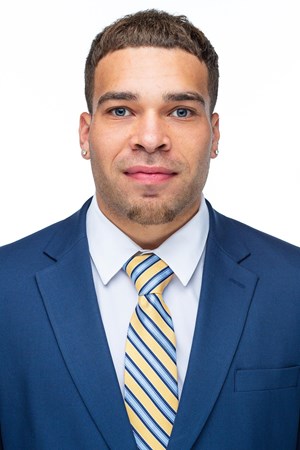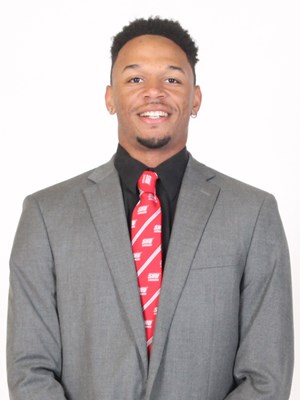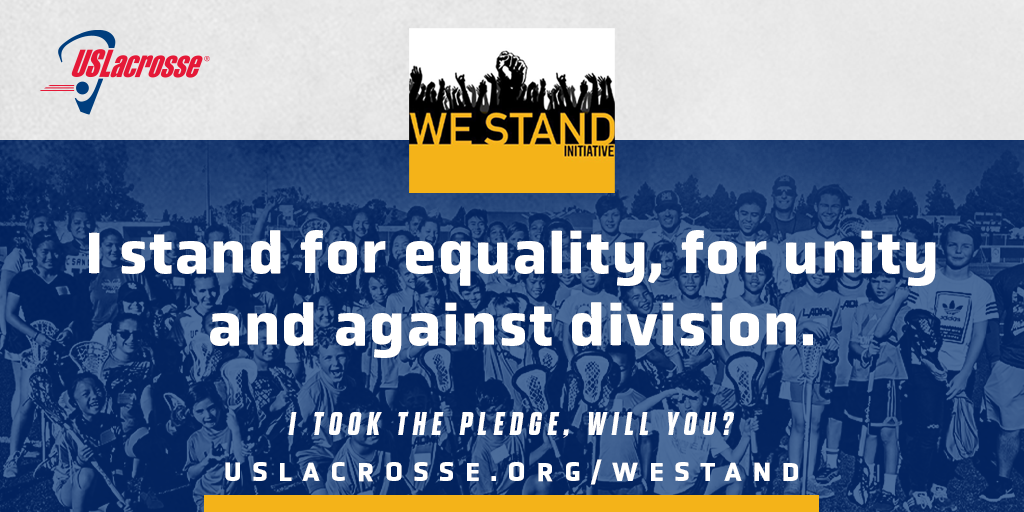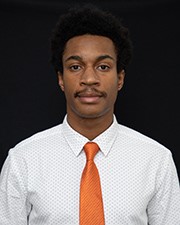“Being biracial in lacrosse has opened my eyes and taught me many lessons,” said Jarrod Davis. “For my opponents that don’t really know me, I may not appear to be African American so personally in college I have never received any discrimination. In high school however, I was on a team with many people with Black teammates and many times walking off the bus we would get weird looks and people laughing. One time in particular I can remember a game when we were playing Canton High school in Connecticut and it was a physical game. One of our players who was black, laid one of their kids out and the kid told him to get the f*** off of him and then used the N word. When our player got to the penalty box, there were fans from the other team yelling at him to take that back to where he came from and saying that this sport isn’t meant for you. So that was definitely sad to hear, and makes you think about other people that feel the same way but just don’t say it out loud.”

Photo courtesy of Quinnipiac Athletics
These are the troubling words from Davis, a division one lacrosse player at Quinnipiac University. He spoke about some of the challenges he faced not only as a biracial player but playing on a team growing up that consisted of other African American teammates along with him.
For years, the sport of lacrosse has been defined by its fast pace and plethora of goals. Much like the quickness of play on the field, lacrosse has been on a complete sprint in world of athletics as one of the fastest growing sports in the world. “Since 1980, the NCAA has added 40 new Men’s [Lacrosse] Division I programs, with 17 of those programs joining the NCAA since the new decade in 2010,” according to Lacrosse All Stars. However, not all that pertains to lacrosse is on such a quick move forward, as lacrosse has struggled immensely with its inclusion of players of color. In 2021, as recorded by the NCAA Demographics Database, only 584 of the 15,000 plus men’s lacrosse players are African American. Thus, comparing to the mere 421 of 12,900 on the women’s lacrosse side.


When looking at these sorts of proportions, it may be easy to simply think that lacrosse is just not a game that people of color take part in. But some of those who do will tell you that it is not as welcoming as it seems, and that some of the backlash the ones who play receive might just be one of the driving forces that keep some of them from the game completely.
As Davis says better than many others could, it hurts to hear the backlash of doing something you love, as well as wondering what others could be thinking but just choosing not to speak. This type of incident is not rare. Another discrimination act that occurred during the 2022 women’s lacrosse season at a game between Presbyterian College and Howard University, an HBCU (Historically Black Colleges and Universities) school. Howard’s team, composed completely of women of color, were met by “a group of white boys tailgating behind a gate” and even called out “directly by name,” according to NBC News.
“This has been an incredibly difficult experience for me and the players,” coach Karen Healy-Silcott said. “It’s not something they should have to face and not something they should ever have heard. It was a really terrible day,” as reported by NBC News’ Char Adams.
Another African American athlete who plays division one lacrosse at Sacred Heart University, Donovan Lacey, spoke about his collegiate experiences with racism. “The most memorable time I had an incident was my freshmen year of college. We were playing at Providence College and I was walking to the wing before a faceoff and one of the attackmen said, ‘you’re playing the wrong sport black boy.’ With it not being the first rodeo, I knew how to handle it. but being at college level and still hearing this kind of stuff shows who people really are,” he said.

Photo courtesy of Sacred Heart Athletics
For some players, they deal with it all the time. For others, maybe very rarely. But the idea that there is room for any type of racism at all in the sport is the idea that needs to change, according to players like Jarrod and Donovan. Lacrosse is a sport that originated with the Native American people some 200 years ago, deemed “The Medicine Game.” It was created as an activity for training young warriors as well as a practice of religion in some cases. Games would last hours, sometimes days long, and were played for their creators. A game that has such rich, beautiful history in its roots has found itself as one of the least ‘accepting’ games of now.
Being a coach in any sport at any age level can be difficult in terms of properly leading your players not only to success on the field, but off the field as a human being. More specific to the sport of lacrosse, it is these types of incidents that need to be coached out of the game. For one coach, Dan Norton, who is the head coach for Hopkinton High School’s varsity lacrosse team out of Massachusetts, he wanted his players to hear stories from one of the game’s most prominent players. He set up a meeting with Kyle Harrison, a nine-time professional all-star and champion in 2017, also one of the premier college players as he was crowned with the Tewaaraton trophy in 2005 as the country’s best player. And by the way, Harrison is an African American lacrosse player.

Photo courtesy of the PLL
“Over the pandemic, [Kyle] joined our team on zoom call to speak to our player’s about lacrosse in general and the beauties of the game. Also, he spoke on his career and what it was like to be an African American in a white-dominated sport,” said Coach Norton.
In any case, to see that a player of such a caliber as Harrison talk about the difficulties that even he faces as one of the greatest to ever play, it goes miles for some of the young athletes, Black or white, who consider him to be a role model. It also offers a sense of comfort for young African American players to know that they are not alone in their own situations, and that they have such a strong ally on their side to aide in the fight to end all racism in the sport.
Unfortunately, the incident that occurred for Howard’s lacrosse team is not the only incident seen in collegiate lacrosse. Amherst College suffered two incidents in as many years within its own program. In 2020, the entire team was placed on probation along with their head coach, Jon Thompson, being fired as “members of the men’s lacrosse team chanted the n-word at a black lacrosse player, who then punched one of his teammates who was using the term,” as reported by Daily Hampshire Gazette’s Josh Walfish. Furthermore, “team members exchanging messages in a popular texting app, GroupMe, that were ‘denigrating and ridiculing’ transgender and gender-nonconforming staff members.” The university took action by suspending the team from competition for the 2020 season.
As the next season rolled in, Amherst hired Rashad Devoe, a Black man, as their new head men’s lacrosse coach in 2021. His tenure was not one that lasted much time as he was fired in June “after an investigation into allegations that he verbally mistreated team members who had purportedly violated Amherst’s COVID-19 restrictions by informally practicing on a school green,” as reported by the Boston Globe’s Bob Hohler. Devoe took action into his own hands following his release by speaking on what he says was the racially-motivated mistreating of him and how after the previous incident the year prior as “school officials declined to assure him they would protect him and the students from ‘retaliation and continued discrimination’.
In the lacrosse community and for those who love the game beyond any type of skin color or ethnic descent, there are ways to help spread the message of acceptance. USA Lacrosse, the national governing body of men and women’s lacrosse in the United States, came together with its ‘We Stand’ initiative that is targeted to maximize equality in the game. They state that their “purpose is to create a sense of belonging for all within the sports community by shifting the culture to one that firmly opposes unjust or prejudicial treatment based on racial bias, socioeconomic and familial status, sexual orientation, physical abilities or gender identity.” Through its website, it is possible to take the pledge against division in sports and to further educate yourself on the matter. With the pledge come further links to specific tools for coaches, players. parents, officials, and more. All of this information can be found and further read into here at USA Lacrosse.

Donovan Davis, the manager of diversity, equity, and inclusion for USA Lacrosse, spoke to me about the initiative itself. “The initiative itself is something that was needed in general in my opinion. Not only for the sport of lacrosse but for all sports that are played in this world. For the sport of lacrosse specifically, We Stand is an initiative that shows that there is togetherness, support for one another, and community. Whether it be from the highest level of play to the lowest, it shows that the events that have occurred in the past, present, or future will not be accepted but challenged. We Stand Initiative stands for that and much more,” he said.
Fortunately, it is not all African American athletes that have to constantly deal with this backlash. It is also not all that do undergo it let the criticism get under their skin. For Miles Tillman, a division three player at Rochester Institute of Technology, the comments are easily brushed off to the side.

Photo courtesy of RIT Athletics
Tillman grew up playing hockey and lacrosse, both predominantly white sports, and spent more time focusing on his play then the noise around him. He said, “I could care fewer what people say, in hockey and lacrosse I was just trying to focus on being the best I could be.” He also has done a lot of moving around throughout his college career as RIT is now his third college he has attended and spoke on how intertwining himself into each new team was no challenge because it was to him never about race, but about having fun with one another and enjoying the sport he is blessed to continue playing in college. “As I have grown older, I have continued to realize that looks and comments can’t affect me and no matter what happens I am going to keep pushing forward,” he said.
The responses and reactions will vary from person to person. It is important to understand as an outsider that no two people are alike and the way someone may react or deal with negativity toward them will not always be the same. That being said, it is always in the best of interest to understand those around you and keep their feelings and attitudes in mind as well as your own when choosing to open your mouth.
Collegiate athletes that participate in other sports have also taken notice to such discrimination in the game. Kyle Kauzens, former football player at UMass Dartmouth, touched on the events. “I remember reading something on twitter about a lacrosse player being kicked off his team because he recorded himself saying the N word over snapchat with his girlfriend. Watching and listening to that video was extremely tough, and it makes me feel for my teammates who are Black, how they can get hit with these acts of racism at any moment and can’t do anything about it,” he said.
Kauzens touches on the point beautifully that most of these collegiate athletes are encouraged to do exactly that, nothing. That most of them just have to keep their heads held high and keep moving forward. As many of them would hope, that moving forward will lead them to an athletic community filled with inclusion. Where race is nothing and the game is everything.
A world of lacrosse where the only colors that matter are the colors of the jersey.
